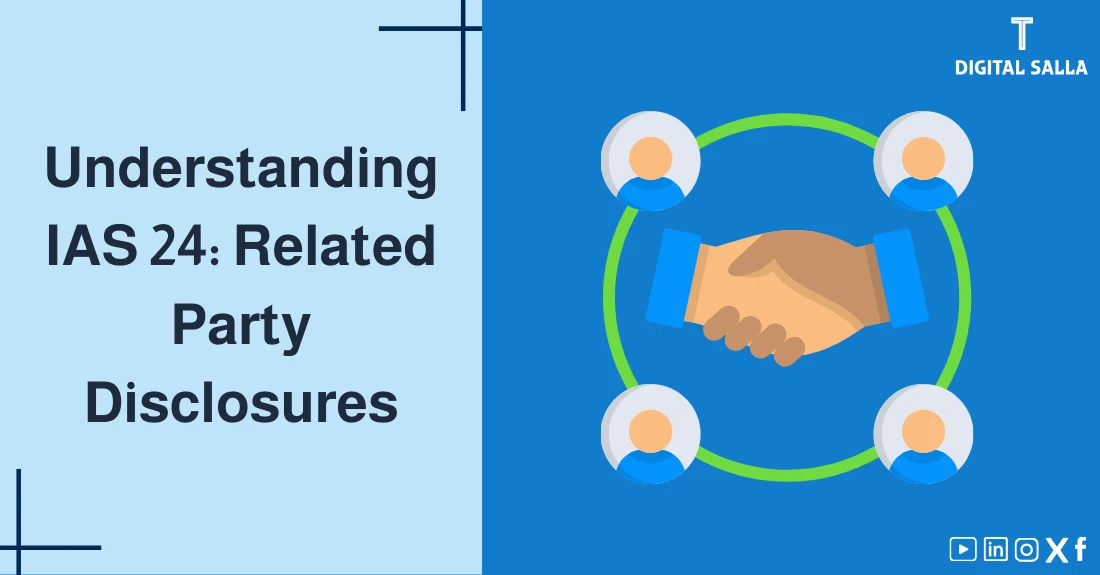Understanding IAS 24 Standard: Related Party Disclosures

IAS 24 Standard, “Related Party Disclosures,” is one of the most important International Financial Reporting Standards (IFRS) that enhances the transparency of financial statements by disclosing transactions and relationships with related parties. IAS 24 Standard aims to ensure that financial statements provide sufficient information about the impact of related parties on the entity’s financial position and financial performance. In this article, we will provide a thorough explanation of IAS 24 Standard, discussing its objectives, scope, and key definitions, focusing on identifying related parties and the types of transactions that must be disclosed, as well as highlighting the importance of this standard and its impact on the quality of financial reporting.
What are Related Parties?
IAS 24 Standard defines a related party as a person or entity that is related to the entity that is preparing its financial statements (the “reporting entity”).
Related parties can be divided into two main categories:
- Related Persons: A person or a close member of that person’s family is related to a reporting entity if that person:
- Has control or joint control over the reporting entity.
- Has significant influence over the reporting entity.
- Is a member of the key management personnel of the reporting entity or of a parent of the reporting entity.
- That person’s children, spouse or domestic partner, and parents.
- Children of that person’s spouse or domestic partner.
- Dependants of that person or that person’s spouse or domestic partner.
- Related Entities: An entity is related to a reporting entity if any of the following conditions applies:
- The entity and the reporting entity are members of the same group (which means that each parent, subsidiary, and fellow subsidiary is related to the others).
- One entity is an associate or joint venture of the other entity.
- Both entities are joint ventures of the same third party.
- One entity is a joint venture of a third entity, and the other entity is an associate of the third entity.
- The entity is a post-employment benefit plan for the benefit of employees of either the reporting entity or an entity related to the reporting entity.
- The entity is controlled or jointly controlled by a person identified in (1).
- A person identified in (1)(a) has significant influence over the entity or is a member of the key management personnel of the entity (or of a parent of the entity).
- The entity, or any member of a group of which it is a part, provides key management personnel services to the reporting entity or to the parent of the reporting entity.
What is IAS 24 Standard: Related Party Disclosures?
IAS 24 Standard is an International Financial Reporting Standard that specifies the disclosure requirements for information about transactions and outstanding balances with related parties. The standard does not address the measurement of these transactions; rather, it focuses on their disclosure.
Objectives of IAS 24 Standard:
- Ensure Disclosure of the Existence of Related Party Relationships: IAS 24 Standard aims to ensure that an entity discloses the existence of any relationships with related parties, even if no transactions have occurred between them during the period.
- Disclosure of Transactions with Related Parties: IAS 24 Standard requires the disclosure of all transactions that occur between the entity and its related parties, including the nature of the transaction, its amount, and its terms.
- Disclosure of Outstanding Balances with Related Parties: Any outstanding debit or credit balances between the entity and its related parties at the financial statement date must be disclosed.
- Improve Transparency and Reliability of Financial Statements: The disclosures required by IAS 24 Standard help improve the transparency and reliability of financial information by highlighting the impact of related parties on the entity’s financial position and financial performance.
- Enable Users of Financial Statements to Assess Risks: IAS 24 Standard helps users of financial statements assess the risks associated with the entity’s dealings with related parties, such as the risks of conflicts of interest or unfair transactions.
- Enhance Comparability: IAS 24 Standard contributes to improving the comparability of financial statements of companies by standardizing the disclosure requirements for related parties.
Scope of IAS 24 Standard:
IAS 24 Standard applies to all entities that prepare financial statements in accordance with IFRS, including:
- Separate financial statements.
- Consolidated financial statements.
Transactions with Related Parties:
IAS 24 Standard defines a related party transaction as a transfer of resources, services, or obligations between a reporting entity and a related party, regardless of whether a price is charged.
Examples of Related Party Transactions:
- Purchases or sales of goods.
- Purchases or sales of property and other assets.
- Rendering or receiving of services.
- Leases.
- Transfers of research and development.
- Transfers under license agreements.
- Transfers under finance arrangements (including loans and equity contributions in cash or in kind).
- Provision of guarantees or collateral.
- Settlement of liabilities on behalf of the entity or by the entity on behalf of another party.
- Participation by a parent or subsidiary in a defined benefit plan that shares risks between group entities.
Disclosure Requirements under IAS 24 Standard:
IAS 24 Standard requires entities to disclose the following information:
- Relationships between Parents and Subsidiaries:
- The name of the parent and, if different, the ultimate controlling party must be disclosed.
- If neither the reporting entity nor the parent issues financial statements available for public use, the name of the next most senior parent that does so must be disclosed.
- Key Management Personnel Compensation:
- Total key management personnel compensation must be disclosed separately.
- Key management personnel compensation must be disclosed for each of the following categories:
- Short-term employee benefits.
- Post-employment benefits.
- Other long-term employee benefits.
- Termination benefits.
- Share-based payments.
- Related Party Transactions: If there have been transactions between related parties, the entity must disclose:
- The nature of the related party relationship.
- Information about the transactions and outstanding balances, including commitments, necessary for an understanding of the potential effect of the relationship on the financial statements.
- The amount of the transactions.
- The amount of outstanding balances, including:
- Their terms and conditions, including whether they are secured, and the nature of the consideration to be provided in settlement.
- Details of any guarantees given or received.
- Provisions for doubtful debts related to the amount of outstanding balances.
- The expense recognized during the period in respect of bad or doubtful debts due from related parties.
- The parent.
- Entities with joint control or significant influence over the entity.
- Subsidiaries.
- Associates.
- Joint ventures in which the entity is a venturer.
- Key management personnel of the entity or its parent.
- Other related parties.
Importance of IAS 24 Standard for Users of Financial Statements:
IAS 24 Standard provides valuable information to users of financial statements, such as investors and analysts, as it helps them to:
- Understand the impact of related parties on the entity’s financial position and financial performance.
- Assess the risks of transactions with related parties, such as the risks of conflicts of interest or unfair transactions.
- Determine whether transactions with related parties are on arm’s length terms.
- Compare the performance of different companies more accurately.
- Make more informed investment and financing decisions.
Challenges in Applying IAS 24 Standard:
- Identifying All Related Parties: It can be challenging to identify all related parties, especially in companies with complex structures.
- Gathering the Necessary Information: It can be difficult to gather the necessary information to disclose all transactions and outstanding balances with related parties.
- Determining Whether Transactions with Related Parties are on Arm’s Length Terms: This requires a significant amount of judgment and professional skepticism.
- Ensuring Compliance with Disclosure Requirements: Companies must ensure that they disclose all the information required by IAS 24 Standard fully and accurately.
Role of Technology in Applying IAS 24 Standard:
Accounting software and Enterprise Resource Planning (ERP) systems help in applying IAS 24 Standard more efficiently and accurately by:
- Automatically identifying related parties.
- Tracking transactions and outstanding balances with related parties.
- Generating the reports necessary to comply with disclosure requirements.
- Improving the accuracy and comprehensiveness of related party disclosures.
Examples of Applying IAS 24 Standard:
Example 1:
- Scenario: Company “A” owns 70% of the shares of Company “B.”
- Analysis: Company “B” is a related party of Company “A” because Company “A” controls it.
- Disclosure: Company “A” must disclose the nature of the relationship with Company “B” in its financial statements and disclose any transactions or outstanding balances between the two companies.
Example 2:
- Scenario: Mr. “C,” the CEO of Company “D,” purchased a piece of land from the company at a price below its market value.
- Analysis: Mr. “C” is a related party of Company “D” because he is a member of key management personnel.
- Disclosure: Company “D” must disclose this transaction in its financial statements, including a description of the transaction, its amount, and its terms.
Example 3:
- Scenario: Company “E” provided an interest-free loan to Company “F”, which is controlled by the family of a board member of Company “E”.
- Analysis: Company “F” is a related party of Company “E”.
- Disclosure: Company “E” must disclose this transaction in its financial statements, including the loan amount and its terms.
Relationship with Other IAS Standards:
IAS 24 Standard is related to several other IFRSs, such as:
- IFRS 10, “Consolidated Financial Statements”: Determines how to identify control, which is a key element in the definition of related parties.
- IAS 28, “Investments in Associates and Joint Ventures”: Specifies how to account for investments in associates and joint ventures, which are related parties.
- IFRS 3, “Business Combinations”: Requires the disclosure of information about related party transactions in the context of a business combination.
Conclusion:
IAS 24 Standard, “Related Party Disclosures,” is an essential tool for enhancing the transparency and reliability of financial statements by disclosing information about transactions and outstanding balances with related parties. Companies must comply with the requirements of this standard to ensure that they provide fair and reliable financial information that meets the needs of users of financial statements. Understanding IAS 24 Standard is essential for accountants, auditors, investors, and anyone seeking to understand how related parties affect an entity’s financial position and financial performance.
